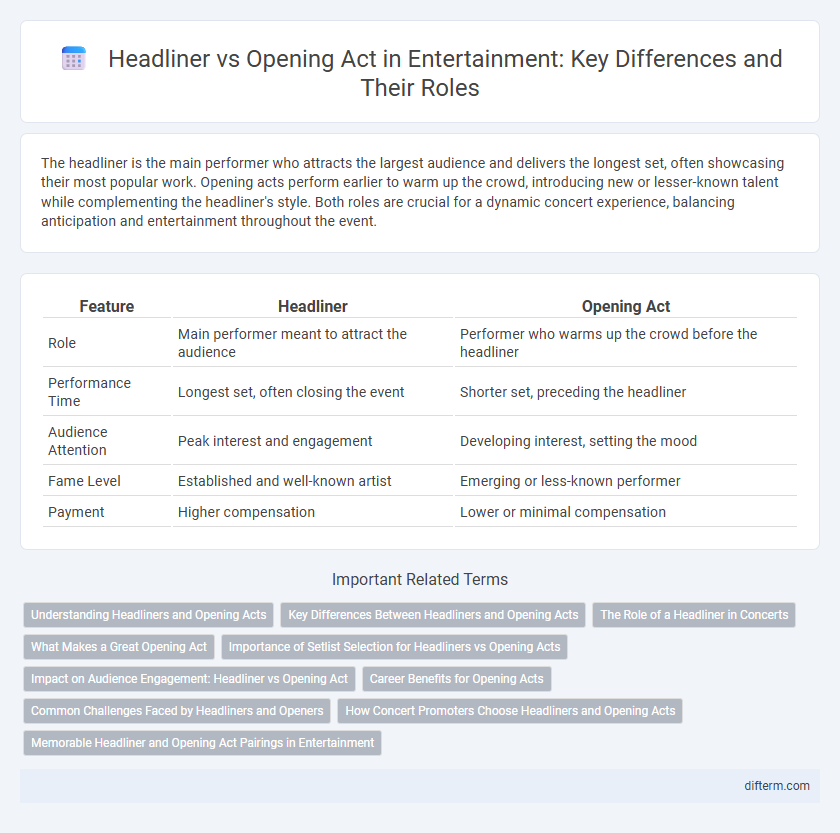The headliner is the main performer who attracts the largest audience and delivers the longest set, often showcasing their most popular work. Opening acts perform earlier to warm up the crowd, introducing new or lesser-known talent while complementing the headliner's style. Both roles are crucial for a dynamic concert experience, balancing anticipation and entertainment throughout the event.
Table of Comparison
| Feature | Headliner | Opening Act |
|---|---|---|
| Role | Main performer meant to attract the audience | Performer who warms up the crowd before the headliner |
| Performance Time | Longest set, often closing the event | Shorter set, preceding the headliner |
| Audience Attention | Peak interest and engagement | Developing interest, setting the mood |
| Fame Level | Established and well-known artist | Emerging or less-known performer |
| Payment | Higher compensation | Lower or minimal compensation |
Understanding Headliners and Opening Acts
Headliners are the main performers in an entertainment event, typically drawing the largest audience due to their popularity and reputation. Opening acts are artists or groups who perform before the headliner, aiming to warm up the audience and gain exposure. The distinction lies in prominence, with headliners receiving longer set times and greater billing on promotional materials.
Key Differences Between Headliners and Opening Acts
Headliners are the main performers who attract the largest audience and typically have longer set times, higher-profile recognition, and greater production resources. Opening acts play a supporting role, warming up the crowd with shorter performances and often gaining exposure by associating with the headliner. The key differences lie in billing prominence, time allocation, and overall impact on the event's draw and atmosphere.
The Role of a Headliner in Concerts
The role of a headliner in concerts is to attract the largest audience and deliver the main performance, often showcasing their most popular songs and stage presence. Headliners typically perform after the opening act, setting the tone and culminating the event with a high-energy show that defines the concert experience. Their established reputation and fan base drive ticket sales and overall event success.
What Makes a Great Opening Act
A great opening act captivates the audience with energetic performances that set the tone for the headliner, showcasing originality and strong stage presence. Successful openers engage the crowd without overshadowing the main artist, creating anticipation and enhancing the overall concert experience. Effective use of crowd interaction and tailored setlists tailored to the event's genre are key factors in winning over the audience early on.
Importance of Setlist Selection for Headliners vs Opening Acts
Setlist selection is crucial for headliners and opening acts, as headliners typically tailor their sets to include crowd favorites and longer performances to maximize audience engagement and showcase their signature style. Opening acts often focus on energetic, concise sets that introduce their sound while complementing the headliner's vibe and maintaining audience interest. Strategic song choices for both roles impact overall concert flow, audience retention, and the success of the live show.
Impact on Audience Engagement: Headliner vs Opening Act
The headliner commands the audience's full attention by delivering a highly anticipated, memorable performance that shapes the overall event experience. In contrast, the opening act plays a crucial role in warming up the crowd, setting the tone, and building excitement for the headliner, which influences audience energy levels and engagement. Effective synergy between headliner and opening act enhances attendee satisfaction and boosts the event's emotional impact.
Career Benefits for Opening Acts
Opening acts gain crucial exposure by performing before larger audiences, often attracting new fans and industry attention. These performances help build stage experience and enhance credibility within the entertainment industry. Establishing connections with headliners and promoters can lead to future career opportunities and collaborations.
Common Challenges Faced by Headliners and Openers
Headliners and opening acts both face distinct challenges, with headliners managing audience expectations and maintaining high energy throughout the performance, while openers work to captivate a crowd that is often less engaged or arriving late. Openers struggle with limited stage time and less production support, making it difficult to showcase their full talent. Both roles require adaptability and resilience to overcome the pressures of live performance dynamics and audience reception.
How Concert Promoters Choose Headliners and Opening Acts
Concert promoters choose headliners based on factors like audience draw, social media presence, and past ticket sales performance to maximize event profitability. Opening acts are typically selected for their potential to complement the headliner's style and to engage the audience while building their own fanbase. Market research and demographic alignment also play crucial roles in pairing acts effectively for a successful concert experience.
Memorable Headliner and Opening Act Pairings in Entertainment
Memorable headliner and opening act pairings in entertainment often create iconic concert experiences, such as Nirvana opening for Sonic Youth or The Rolling Stones with The Faces. These collaborations boost audience engagement by blending different musical styles while spotlighting emerging talent alongside established superstars. Strategic pairing enhances overall show appeal, driving ticket sales and long-term fan loyalty.
headliner vs opening act Infographic

 difterm.com
difterm.com